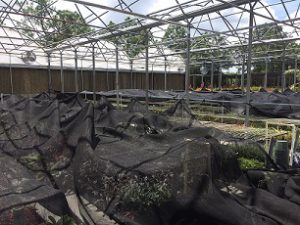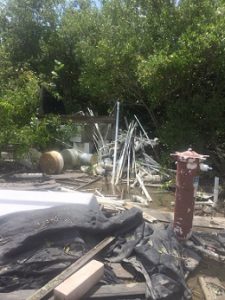In Martin County, Hurricane Dorian brought a potential for Category 5 storm force winds, rain, and storm surge. Nursery, vegetable, aquaculture and other growers facing storms like Dorian must prepare for the worst. Preparation and recovery efforts cost agribusinesses, even when the winds and rains are thankfully minimal. Below are described some of the impacts borne by growers in Martin County as a result of storms like Hurricane Dorian.
Replacement of Removed/Damaged Materials

For growers with greenhouse and/or shadehouse structures, storm prep typically includes removal of the plastic or shadecloth covering. Without the covering, plantings housed in the structures require extra care. For example, seedlings and other sensitive plants may be stored in an enclosed building until the storm’s passage. Alternatively, growers may need to leave the plants in place within the structure. Plants moved into buildings can suffer from lack of light and/or high heat. Damage is worsened with a slow-moving storm like Dorian where plants must stay indoors for a longer period of time. Even without high winds or rain, plants left under the uncovered greenhouse or shadehouse structure can be damaged by exposure to full sun. Plants that are too damaged must then be replaced at a cost to the business.
Replacement of damaged or lost materials isn’t often easy, especially when a storm affects large areas of the state. For example, growers sometimes source vegetable or ornamental plantings from South Florida. A storm travelling up the coast can impact both the buyer and the seller. Aquaculture producers may have difficulty acquiring healthy wild brood stock for their operations, when water quality in their source area has been impacted by storm discharges.
Shadehouse and greenhouse coverings can often be simply rolled back and fastened on top of structures until the storm passes. However, the design of some greenhouse structures does not allow for roll-back of the material. Growers then cut gashes into the plastic or cut and remove it entirely, to protect their greenhouse framework. They must then replace the plastic, even if no wind damage occurred.
For aquaculture producers, stock may be lost due to loss of electricity and/or coastal flooding. Aquaculture operations often depend on electricity, mainly to deliver water via pumps. Any outages that occur, even during relatively minor storms, can threaten survival of cultured animals. Some aquaculture facilities are located near the coastline, making the industry particularly vulnerable to storm surge and higher than normal tides. With Hurricane Dorian, higher than normal tides led to coastal flooding, impacting aquaculture producers.
Labor Costs

Storm preparation and recovery both involve a significant amount of labor. Preparation tasks include removal of shadehouse/greenhouse coverings, movement of plants to sheltered locations, laying down large potted plants in the direction of the prevailing wind, securing loose materials, etc. Likewise, recovery requires that all be placed back in order. Laborers must be paid, even though business income is typically reduced or absent during storm preparation, passage, and recovery periods.
Lost Business Income
As a storm approaches, normal business operations must be placed on hold or slowed as resources are diverted for storm preparation. Workers who would have been propagating, planting, maintaining, or retailing agricultural products must now help instead with storm prep. Vegetables ready for field planting and ornamental seedlings ready for potting must be held back, shifting eventual harvest/sale dates further out into the future. In some cases, the plants and other materials on-site are damaged and must be replaced, again resulting in a loss of income. Vegetable growers, aquaculture producers and nurseries sometimes contract with a buyer to sell their product; when a storm comes, contract deliverables may be delayed or destroyed. At retail establishments, customers are not as likely to shop for plants or produce just before, during, or after a storm, so business income can decline. After the storm passes, workers must focus on recovery, further delaying the flow of products to market. So, even without direct storm damage from winds and rain, growers must manage storm-related costs and income losses.
Help for Growers
Growers face significant impacts from storms, even those that do not ultimately cause major wind damage or rainfall. The USDA offers resources, including technical advice and funding, for growers preparing for and recovering from storms. One such source is the USDA website: Hurricane Dorian Preparedness and Recovery Resources. For fisheries, including aquaculture, NOAA offers disaster assistance resources. UF/IFAS Extension, including County Extension Agents, assists in documenting agricultural damage and connecting growers with resources that may help them before and after storms and other disasters. The UF/IFAS Disaster Preparation and Recovery website offers more information from the University of Florida. Consumers can help by shopping local and being patient with agribusinesses, whether it’s a retail nursery that may remain in recovery mode for a week or more after the storm, to a favorite CSA or retail vegetable grower that isn’t able to provide their normal produce as early as expected.
Acknowledgements
Thanks to Vincent Encomio, UF/IFAS Extension Martin & St. Lucie County Sea Grant Agent, for sharing impacts faced by aquaculture producers in Martin County, as well as aquaculture disaster assistance resources. In appreciation to the many Martin County growers who were open to sharing what they go through and how they prepare for and recover from storms like Hurricane Dorian, even as they were working hard to return to normal operations.
 0
0
